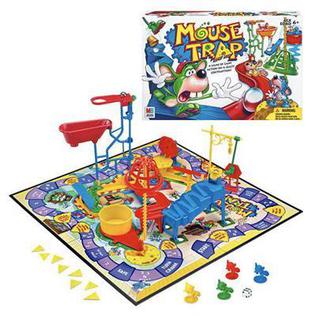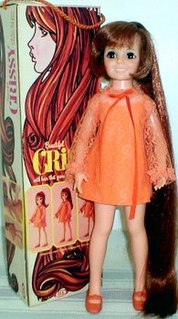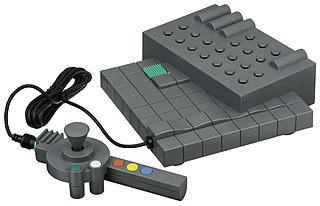 W
WIdeal Toy Company was an American toy company founded by Morris Michtom and his wife, Rose. During the post–World War II baby boom era, Ideal became the largest doll-making company in the United States. Their most popular dolls included Betsy Wetsy, Toni, Saucy Walker, Shirley Temple, Miss Revlon, Patti Playpal, Tammy, Thumbelina, Tiny Thumbelina, and Crissy. Their last big hit was the Rubik's Cube.
 W
WAlexander's Star is a puzzle similar to the Rubik's Cube, in the shape of a great dodecahedron.
 W
WMouse Trap is a board game first published by Ideal in 1963 for two to four players. It is one of the first mass-produced three-dimensional board games. Over the course of the game, players at first cooperate to build a working Rube Goldberg-like mouse trap. Once the mouse trap has been built, players turn against each other, attempting to trap opponents' mouse-shaped game pieces.
 W
WCrissy is an American fashion doll with a feature to adjust the length of its hair. Crissy was created in the Ideal Toy Corporation's prototype department in 1968. She has auburn hair and is 18 inch (36 cm) tall. While having stationary foundation or base hair rooted to its head, the Crissy doll also had another thick strand or lock of hair that emerged from an opening in the top of the doll's head, which could be lengthened or shortened with a knob in the doll's back so a child could choose to make the hair short or long.
Flatsy Dolls are flat dolls that were made by Ideal Toy Company from 1969 through 1973. Designed by Hank Kramer, Flatsy Dolls were originally marketed to little girls. Like many vintage dolls, Flatsy dolls are now collectors items.
 W
WHands Down is a board game originally created in 1964 by Marvin Glass and Harvey "Hank" Kramer for Ideal Toy Company. Hasbro, Milton Bradley, and Pressman Toy Corporation have published the game over the years. The game is for ages 5 and up. Hands Down is a card game with a speed/reaction component in the same category as Spoons. There is a plastic game unit with different colored hand-shaped paddles to slap on instead of grabbing a spoon.
 W
WKerPlunk is a children's game invented by Eddy Goldfarb with Rene Soriano and first marketed by the Ideal Toy Company in 1967. The game consists of a transparent plastic tube, plastic rods called straws and several dozen marbles. The base contains four separate numbered trays and the straws are passed through holes in the middle of the tube to form a lattice. The marbles are then placed in the top of the tube and held in place by the lattice. The onomatopoeic name of the game derives from the sound of the marbles tumbling to the base of the tube during play.
 W
WMouse Trap is a board game first published by Ideal in 1963 for two to four players. It is one of the first mass-produced three-dimensional board games. Over the course of the game, players at first cooperate to build a working Rube Goldberg-like mouse trap. Once the mouse trap has been built, players turn against each other, attempting to trap opponents' mouse-shaped game pieces.
 W
WThe Rubik's Cube is a 3-D combination puzzle invented in 1974 by Hungarian sculptor and professor of architecture Ernő Rubik. Originally called the Magic Cube, the puzzle was licensed by Rubik to be sold by Ideal Toy Corp. in 1980 via businessman Tibor Laczi and Seven Towns founder Tom Kremer. Rubik's Cube won the 1980 German Game of the Year special award for Best Puzzle. As of January 2009, 350 million cubes had been sold worldwide, making it the world's bestselling puzzle game and bestselling toy.
 W
WThe Rubik's Revenge is a 4×4×4 version of Rubik's Cube. It was released in 1981. Invented by Péter Sebestény, the Rubik's Revenge was nearly called the Sebestény Cube until a somewhat last-minute decision changed the puzzle's name to attract fans of the original Rubik's Cube. Unlike the original puzzle, it has no fixed facets: the centre facets are free to move to different positions.
 W
WShaker Maker is a toy for making figures. Water and a powder must be mixed in a shaker and after turning the shaker the mixture flows into moulds inside the shaker. Because of fast polymerisation the consistency of the mixture becomes like pudding in seconds. After some days it hardens.
 W
WTammy was a 12" fashion doll created by the Ideal Toy Company that debuted at the 1962 International Toy Fair. Advertised as "The Doll You Love to Dress", Tammy was portrayed as a young American teenager, more "girl next door" than the cosmopolitan image of Mattel's Barbie, or American Character's Tressy.
 W
WToss Across is a game first introduced in 1969 by the now defunct Ideal Toy Company. The game was designed by Marvin Glass and Associates and created by Hank Kramer, Larry Reiner and Walter Moe, and is now distributed by Mattel. It is a game in which participants play tic-tac-toe by lobbing small beanbags at targets in an attempt to change the targets to their desired letter. As in traditional tic-tac-toe, the first player to get three of their letters in a row wins the game. There are other similar games to Toss Across known under different names, such as Tic Tac Throw.
 W
WUp Against Time is a children's game first marketed by the Ideal Toy Company in 1977.
 W
WView-Master Interactive Vision is an interactive movie VHS console game system, introduced in 1988 and released in the USA in 1989 by View-Master Ideal Group, Inc. The tagline is "the Two-Way Television System that makes you a part of the show!" The titles include four Sesame Street games, two games featuring the Muppet Show characters, and a Disney game, Disney's Cartoon Arcade.